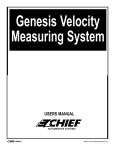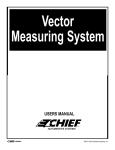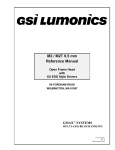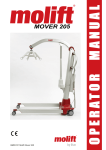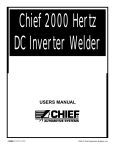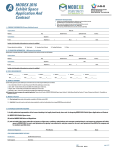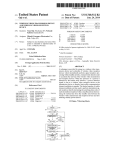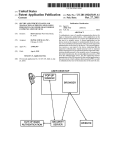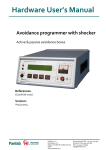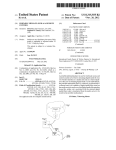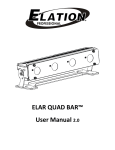Download LASER LOCK LIVE MAPPING SYSTEM
Transcript
LASER LOCK LIVE MAPPING SYSTEM USERS MANUAL For: Spanish See DVD sent with unit. French German etc. 788438 2015 © Chief Automotive Technologies CO9326 Rev A 3/5/15 Table Of Contents I. INTRODUCTION1 LASER LOCK LIMITED WARRANTY AGREEMENT GENERAL OVERVIEW1 About This Manual1 Training1 VARIANCES: GRAPHICS / SPECIFICATIONS2 Specifications Versus Vehicle Measurements2 GENERAL SAFETY INFORMATION3 Controls3 Laser Safety Information3 Federal Communications Commission4 COPYRIGHT INFORMATION4 Laser Lock Users Manual4 Laser Lock Software4 LASER LOCK ASSISTANCE5 II. LASER LOCK HARDWARE 6 COMPONENT TERMINOLOGY6 COMPONENT OVERVIEWS7 Workstation7 Body Scanner and Tray8 Targets9 Target Base10 Attachments / Clips / Extensions11 Magnetic Attachments11 Bolt Attachments12 Hole Attachments12 Extensions13 Upper Body Bar Assembly14 Spacers and 3 Inch Bolts16 Chief Specifications Data16 Literature16 Diskettes and CDs17 COMPONENT MAINTENANCE18 COMPONENT TROUBLESHOOTING20 III. LASER LOCK PROGRAM 21 STARTING UP LASER LOCK SYSTEM21 LASER LOCK WINDOWS AND MENUS23 SHUTTING DOWN LASER LOCK SYSTEM23 WINDOWS24 DIALOG BOXES26 VEHICLE GRAPHICS28 KEYBOARD, MOUSE AND PEN30 SPECIAL KEYS33 LASER LOCK WINDOWS AND MENUS35 HELP TEXT36 HOW TO USE HELP38 LASER LOCK TUTORIAL40 LASER LOCK WIZARD40 2 LASER LOCK LIVE MAPPING SYSTEM LIMITED WARRANTY AGREEMENT Chief Automotive Technologies, Inc. warrants for one year from date of purchase any components of its Laser Lock Live Mapping System and 18 months for its Laser Lock Scanner which do not perform satisfactorily due to defect caused by faulty material or workmanship. THE WARRANTY DESCRIBED HEREIN SHALL BE IN LIEU OF ANY OTHER WARRANTY, EXPRESS OR IMPLIED, INCLUDING BUT NOT LIMITED TO, ANY IMPLIED WARRANTY OF MERCHANTABILITY, OF FITNESS FOR A PARTICULAR PURPOSE, OF TITLE, OR OTHERWISE ON THE PART OF CHIEF AUTOMOTIVE TECHNOLOGIES, THE EQUIPMENT, THE SPECIFICATIONS CONTAINED THEREIN OR ANY UNIT THEREOF. Chief’s obligation under this warranty is limited to the repair or replacement of components which are defective and which have not been misused, carelessly handled, or defaced by the repair or repairs made or attempted by others. Chief Automotive Technologies does not assume responsibility for any injury or property damage resulting from the operator’s misuse of this product. Unless a statement made by any representative of Chief Automotive Technologies is identified as a warranty, any such statements shall not be construed to constitute warranties and do not form part of the basis of the bargain; it being expressly understood that such statements are merely made in the course of the negotiations of the parties. FURTHERMORE, Chief Automotive Technologies specifically excludes or disclaims any warranty, express or implied, based on any sample or model shown by Chief Automotive Technologies to the buyer for demonstration purposes only. LIMITATION OF REMEDIES. The parties agree that the buyer’s sole and exclusive remedy against Chief Automotive Technologies shall be for the repair or replacement of components which are defective and which have not been misused, care- lessly handled, or defaced by the repair or repairs made or attempted by others. The buyer agrees that no other remedy (including, but not limited to, incidental or consequential damages for lost profits, lost sales, injury to person or property, or any other incidental or consequential loss) shall be available to him. This exclusive remedy shall not be deemed as to have failed of its essential purpose so long as Chief Automotive Technologies is willing and able to repair or replace defective parts in the pre- scribed manner. Prior to the return of any merchandise for a warranty claim, contact the Customer Service Department (800-445-9262) for a Returned Goods Authorization Number and instructions. No goods may be returned without a Returned Goods Authorization Number. The buyer shall be required to deliver the defective part to Chief Automotive Technologies UNLESS (1) the part was destroyed as a result of its defect or of any defect in any part covered in this warranty, AND (2) Chief is reasonably satisfied that the part was defective at the time of its failure. DISCLAIMER OF WARRANTY THE GRAPHICS AND DATA SUPPLIED WITH THE LASER LOCK SYSTEM HAVE BEEN COMPILED FROM AUTHORITATIVE SOURCES. EVERY EFFORT HAS BEEN MADE BY CHIEF AUTOMOTIVE TECHNOLOGIES, TO ASSURE ACCURACY; HOWEVER, MANUFACTURING CHANGES, ERRORS OR OMISSIONS MIGHT OCCUR. CHIEF AUTOMOTIVE TECHNOLOGIES DOES NOT ASSUME RESPONSIBILITY NOR CAN IT BE HELD RESPONSIBLE FOR THE LOSS OR DAMAGE RESULTING FROM VEHICLE MANUFACTURER’S CHANGES, ERRORS, OR OMISSIONS IN THIS SYSTEM. LASER LOCK LIVE MAPPING SYSTEM WARRANTY REGISTRATION FORM Please fill out completely and detach from Laser Lock Users Manual. Return form to: Chief Automotive Technologies, 996 Industrial Drive Madison, Indiana 47250 Accepted this day of 20 Serial Numbers: System Shop Name: Body Scanner Address: Computer City, State, Zip: Monitor By: Printer Title: 3 I. INTRODUCTION GENERAL OVERVIEW Whether detecting misalignment in a vehicle’s structure or verifying repairs have eliminated the dam- age, Laser Lock computerized measuring system can do the job. Laser Lock integrates the precision of laser scanning with a computerized data base for unmatched accuracy in collision repair and analysis. In addition to showing extent of collision damage, Laser Lock monitors progress throughout the repair and verifies the vehicle’s structure is correctly aligned. Printed reports verify the vehicle’s structural con- dition by showing overhead diagrams that display centerline, datum line and datum height measure- ments. The Laser Lock system measures on the principle of triangulation. The system’s electronic Body Scanner houses Laser Lights that reflect off of revolving mirrors toward light-reflective Targets (each bearing a unique code) that are suspended from vehicle’s reference points. The Body Scanner houses photo sensors that identify the angle of revolving laser reflections. This information is transferred to the com- puter which performs the triangulation and Target identification functions. About This Manual This manual provides information on basic hardware components. It also provides pertinent informa- tion regarding startup/shutdown procedures, examples of on-screen Windows/Dialog Boxes and Vehicle Graphics, Keyboard/Mouse/Pen functions, Special Keys, and information on how to use the Laser Lock Help Text. Pertinent software functions and parts ordering information appear in the Laser Lock Basic Training Manual and Laser Lock Parts Manual. Chief Automotive Technologies reserves the right to alter product specifications and/or package components without notice. Also, components shown in this manual may vary slightly in appearance from those that are actually supplied with the Laser Lock Live Mapping system. Training Chief Automotive Technologies also offers professional training. For maximum productivity and equipment utilization, each person operating a Laser Lock Live Mapping system should receive training conducted by Chief Training Department personnel. For information about training locations and dates, contactChief Automotive Technologies, Tel 800-445-9262 Option 2, Fax 866-275-0173. , Attn: Training Department or contact your local representative. 4 VARIANCES: GRAPHICS/SPECIFICATIONS Graphics The Graphics displayed by the Laser Lock Live Mapping system are of high quality and have been checked for accuracy, but may not reflect the vehicle’s actual appearance in every detail. Variances may exist as a result of changes made by vehicle manufacturers or details omitted as a result of space limita- tions. Specifications Versus Vehicle Measurements A vehicle’s final measurements may vary from specifications listed and still be aligned correctly. Variances between vehicle measurements and specifications result from one or a combination of the following conditions: • Vehicle specifications are compiled from vehicle manufacturer’s engineering drawings and/or the mea- suring of new (undamaged) vehicles. • Most vehicle manufacturers control only a small number of reference points on vehicle’s lower structure. These reference points are commonly referred to as master control points, class one control points, prin- ciple locating points, etc. Each of these control points is usually held to a tolerance of plus or minus 3mm in three dimensions (length, width, height). Other reference points have a larger tolerance, but generally, a tolerance of plus or minus 5mm in three dimensions (length, width, height) is considered ‘normal’ according to Chief Automotive Technologies experience. In Arrow Display Mode, reference point measurements that exceed toler- ance appear in ‘red’ whereas those falling within tolerance appear in ‘blue’. • Some reference points used for dimensioning the same make and model of vehicle vary from one manufacturing plant to another. Also, periodic manufacturing improvements can affect the location of points used for dimensioning. Key points to remember when realigning a vehicle: • Length and width dimensions on each side of vehicle should be within plus or minus 3mm of each other when control or reference points are symmetrical. Frequently, the height at front and rear of vehicle will exceed this tolerance according to Chief Automotive Technologies experience. • When excessive pressure is needed near end of realignment process, and when area around spot welds begins to deform, ‘stop pulling’ and ‘re-evaluate the repair’. This situation usually occurs when a vehicle’s components were not placed on specification during manufacture. In this case, continuing to pull in an attempt to achieve an exact specification may actually damage the vehicle. • When a vehicle’s dimensions vary beyond ‘normal’ tolerances, it is the repair technician’s responsibili- ty to determine if dimensional variances will affect suspension and steering alignment, the safe operation and handling of vehicle, and alignment of body panels. 5 GENERAL SAFETY INFORMATION CAUTION Use of controls or adjustments or performance of procedures other than those specified in this Users Manual may result in hazardous radiation exposure. See CAUTIONS on Workstation and Body Scanner. (See illustration below.) IMPORTANT DO NOT plug the Laser Lock system into same line as a welder. The built-in surge protector may not be sufficient to protect against current fluctuations that result from welder use, and it may cause the computer to fail. Also, avoid metal-to metal contact between all components (i.e. Workstation, Body Scanner, Welder, Vehicle Platform). Controls “On”/“Off” switch on Workstation — Allows power to Computer and other electrical components. “On”/”Off” switch on Body Scanner — Allows power to Body Scanner including lasers. Laser Safety Information Laser Power Output: 2.5 mw @ 4.2 x 10-4 sec. Wavelength: 650 - 670 n Meters NOTE: Laser Lock System is for indoor use only. BODY SCANNER NOTE: Properly licensed / certified electrician needed to install the appropriate power cord plug end on main Laser Lock power cord set. Laser Emissions Laser Reflections Always Turn Scanner OFF Before Disconnecting WORKSTATION 6 CAUTION Avoid exposure! Laser radiation is emitted from Body Scanner apertures. General Safety Information (continued) Federal Communications Commission The Laser Lock Live Mapping system has been tested and found to comply with: 1) Limits for a Class A digital device, pursuant to Part 15 of the FCC Rules. 2) CE standards for emissions (EN55011) and Immunity (EN61326). These limits are designed to provide reasonable protection against harmful interference when equipment is operated in a commercial environment. This equipment generates, uses, and can radiate radio frequency energy and, if not installed and used in accordance with users and training manuals provided, may cause harmful interference to radio communications. Operation of this equipment in a residential area is likely to cause harmful interference in which case the user will be required to correct the interference at his own expense. COPYRIGHT INFORMATION Laser Lock Users Manual Vehicle Service Group © 2010. All Rights Reserved. No part of this work covered by copyrights hereon may be reproduced or copied in any form or by any means including, but not limited to, graphics, electronic, or mechanical, including photocopying, taping, printing or information storage and retrieval systems — without written permission of Vehicle Service Group, Madison, Indiana, U.S.A. All inquiries relating to use of this information should be addressed to Chief Automotive Technologies, Tel 800-445-9262 Option 2, Fax 866-2750173. Laser Lock Software Vehicle Service Group © 2010. All Rights Reserved. No part of this work covered by copyrights hereon may be reproduced or copied in any form or by any means including, but not limited to, graphics, electronic, or mechanical, including photocopying, taping, printing or information storage and retrieval systems — without written permission of Vehicle Service Group, Madison, Indiana, U.S.A. All inquiries relating to use of this information should be addressed to Chief Automotive Technologies, Tel 800-445-9262 Option 2, Fax 866-275-0173. 7 LASER LOCK ASSISTANCE Chief Automotive Technologies offers assistance to Laser Lock program operators. When contacting Chief Automotive Technologies, operators should be prepared to give their name, telephone number (including area code), version of software in use and nature of problem encountered. To identify version of software in use, select ‘About’ from list of items under Help heading in any Menu Bar. In U.S.A., call toll free 800-445-9262. If outside U.S.A., contact an authorized Chief Automotive Technologies representative. Computer Program Updates Updates and changes to computer programs will be issued from time to time via computer DVDs. Explanations of changes and instructions for installing them will accompany the DVDs. Specification Updates/Corrections Annually, and as required, updates and additions to vehicle specifications (and instructions for installation) will be made available for purchase. Keeping Records of Service and Updates Owners should keep records of services performed and updates provided. These records will be helpful when placing calls to the toll free support number. 8 II. LASER LOCK HARDWARE COMPONENT TERMINOLOGY Equipment in Chief’s Laser Lock Live Mapping System (see Figure 1) is easy to use and provides accurate readings. Its basic components include: • Computer * • Display Monitor [1] • Keyboard * • Printer * • Workstation [3] • Power Supply [*] • Body Scanner [4] and Tray [5] • Targets [6] and Attachments/Clips [7] • Upper Body Bar [*] • Anchoring Spacer [*] • Literature [*] (*Not shown in Figure 1 — see following pages) Figure 1 CAUTION Use of controls, adjustments or performance of procedures other than those specified in this manual may result in a breach of warranty and could result in hazardous radiation exposure. See CAUTIONS on Workstation and Body Scanner. 9 COMPONENT OVERVIEWS Workstation The Laser Lock Workstation (see Figure 2) is a steel cabinet that houses a Computer, Display Monitor, Keyboard, Printer, Power Supply (+ 12 volt, 5 AMP), and assorted Targets, Attachments, Clips and Scales. The cabinet is supported by casters and features a drawer for the Body Scanner when it is not in use. Laser Lock computer system features a 250 GB hard drive, a DVD drive, 2 GB of memory, includes keyboard and mouse devices, display monitors, and a printer (see Figure 2). Connect the Laser Lock to a 110-volt, 15 amp power source or 220-volt, 5 amp power source. (Check voltage requirements for Laser Lock system being used.) A single purpose line is recommended. Do not use circuits subject to frequent interruptions or outages. Avoid circuits with power surges such as from welders and some power tools. Built-in surge protector may not be sufficient to protect against current fluctuations and it may cause the Laser Lock computer to fail. Avoid metal-to-metal contact between components (i.e. Workstation, Body Scanner, Welder, Vehicle Platform), and move the Laser Lock components away from welding areas to avoid damage from sparks. IMPORTANT Voltage requirements may vary in some countries. Figure 2 10 Position Workstation near work area and attach Body Scanner Cable. Attach Cable end without cylindrical RFI (Radio Frequency Interference) to Workstation. (See Figure 3.) Then attach Cable end with cylindrical RFI suppressor to Body Scanner. (See arrow - Figure 4.) Body Scanner ‘on/off’ switch is shown in Figure 5. (Inset photo for Figure 3 shows connections for a 220-volt, 5 amp Laser Lock System.) IMPORTANT Computer and Body Scanner are precision electronic tools. Movement of components must be done with care. Do not move Workstation during a ‘continuous’ measurement or during program accessing. Power Cable 110 Volt System Figure 3 Body Scanner Cable 220 Volt System Power Cable Body Scanner Cable Figure 4 Figure 5 11 Body Scanner and Tray The Laser Lock system measures on the principle of triangulation. The Body Scanner houses rotating Laser Lights that project toward light reflective Targets (each bearing a unique code) on vehicle’s structure. Body Scanner also houses photo sensors that identify the angle of revolving laser reflections. This information is transferred to computer which performs triangulation and Target identification functions. The Scanner’s parabolic design filters out sunlight allowing for greater productivity. Body Scanner Tray is the base upon which to position Body Scanner. Rubber strips on Tray’s inside edges and insulating feet on bottom of Body Scanner help prevent metal-to-metal contact between Tray and Body Scanner. Insert Body Scanner Tray below vehicle’s center section (see Figure 6) and place Body Scanner on Tray (see Figure 7). Cable port must be under left side (driver’s side) of vehicle. This positioning allows Body Scanner to be synchronized with computer program. Body Scanner does not need to be square to vehicle or level. Make sure, however, it remains in Tray and Tray is stable. It is permissible to reposition Tray any time or shift Body Scanner in the Tray. Laser Lock recalibrates any repositioning in its next measurement cycle. Figure 6 Figure 7 Targets All Targets are numbered and their reflective faces bear a unique code. (See Figure 8). Most Targets are interchangeable, although some have specific uses. An assortment of clips, extensions and other attachment devices provide flexibility in Target placement. All specifications are provided from reference hole and bolt centers. Targets 1 - 40 are interchangeable depending on length of pendant needed. Targets 41 and 42 are used with a Target Base when measuring lower control arms. Targets 43, 44, and 45 are used with Upper Body Bar when measuring strut tower and other upper body reference points. 12 NOTE: 1) Although Targets numbered 1-40 are interchangeable, be consistent when placing them at reference points. 2) With the exception of Targets 41-45, Targets can be used on either side of the vehicle. we recommend placing odd number targets on left side of vehicle for consistancy. Targets 41 and 42, which are primarily used to measure ball joint locations, must be used on the left and right side of the vehicle respectively. Targets 43 and 44, which are used to measure strut tower locations, must be installed on the Lower Bar of the Upper Body Bar Assembly directly below their respective Pointers. Target Number 45 must be in the center of the Lower Bar. Figure 8 Cone Attachment Figure 9 Target Base Any Target except Targets numbered 43, 44 and 45 can be used with the Target Base. (See Figure 9.) Target Base sits on platform and Target is projected upward from it to a reference point. When using Target Base to project a Target to a specific reference point, the Target Pendant requires the addition of a Cone Attachment (see Figure 9) to compensate for absence of an attachment or clip. Targets 41 and 42 are used with the Target Base to make comparison measurements of ball joint locations. 13 Attachments, Clips and Extensions A variety of Attachments, Clips and Extensions allow Targets to be mounted to practically any reference hole or bolt. These include Magnetic Attachments, Bolt Attachments, and Reference Hole Attachments. Extensions are provided allowing Target attachment at hard to reach locations. Magnetic Structural Attachment Magnetic Attachments (see Figures 10 and 11) are used on bottom of structural members when reference holes or other mounting locations are not accessible. This attachment, used primarily for comparative measurements, should be positioned so that its vertical surface is flush with vertical surface of structural member it mounts to. The Target can then be mounted in attachment’s clip. The magnet on the attachment is strong and will maintain its holding power if cared for properly. A Magnet Keeper (see Inset — Figure 11) should be positioned on magnet when the attachment is not in use. IMPORTANT Never use arc welder or heat near Magnetic Attachment as this tends to reduce its holding power. Figure 10 Figure 11 Bolt Attachments Bolt attachments work equally well on the bottom of a structural component or on the side of a structural component. The nylon base of each attachment swivels to allow for easy Target adjustments. Magnetic Bolt Head Attachments - have a strong gripping capability and are designed to fit a wide range of bolt heads. (Figure 12 and its inset show an example of a magnetic bolt head attachment.) Threaded Attachments - allow operator to thread the attachment onto extruding bolt threads. (Figure 13 and its inset show an example of a threaded attachment.) 14 Metal Clip Style ‘Bolt Attachments’ have a strong gripping capability and are designed to fit a wide range of bolts (and nuts) used on a vehicle’s structure. The small size grasps bolts/nuts with a 10 to 20mm diameter. The medium size grasps bolts/nuts with a 15 to 25mm diameter, and the large size grasps bolts/nuts with a 25 to 35mm diameter. (Figure 14 and its inset show an example of a nylon base bolt attachment.) IMPORTANT Metal Clip style ‘Bolt Attachments’ (previously supplied with Laser Lock systems) can still be used to mount Targets. The current Laser Lock program, however, assumes Magnetic or Threaded Bolt Attachments are in use until operator inputs correct information in Change Attachment Dialog Box. Figure 12 Figure 13 Figure 14 Hole Attachments Magnetic Hole Attachments snap into all types of reference holes. They work equally well on the bottom of a structural component or on the side of a structural component. The attachments feature a nylon base which swivels to allow for easy Target adjustments. Magnetic Hole Attachments have a strong gripping capability and are designed to fit a wide range of reference hole sizes. (Figure 15 and its inset show an example of a magnetic hole attachment.) Aluminum Snap In Attachments snap into all types of reference holes. They are made of aluminum and are provided in varying sizes ranging from 10 to 32mm in diameter. (Figure 16 and its insets show an example of an aluminum snap-in attachment.) 15 In addition to these attachments, a small metal clip is provided for mounting Targets to reference holes measuring 5 to 10mm in diameter. (See Figure 17.) IMPORTANT 1) When using Magnetic Hole Attachments (Nylon Base) in elongated (oval) reference holes, refer to Point Information Dialog Box for correct positioning. 2) Large Metal Clip style ‘Hole Attachments’ (previously supplied with Laser Lock systems) can still be used to mount Targets. The current Laser Lock program, however, assumes Magnetic, Snap-In or small Metal Clip Attachments are in use until operator inputs correct information in Change Attachment Dialog Box. Figure 15 Figure 16 Figure 17 Extensions Target Extensions are available in lengths of 156mm and 256mm. (See Figure 18.) A third extension is C-shaped for reaching around obstructions. The Extensions allow greater flexibility when extra length is needed and when mounting Targets in locations where obstructions prevent normal installation. (See Figures 19 and 20 and Figure 19 Inset.) 256mm 156mm C-Shaped (Red) (Blue) Extension Figure 18 Figure 19 16 Figure 20 Upper Body Bar Assembly The Upper Body Bar Assembly consists of two horizontal bars joined by a pair of Vertical Scales. (See Figure 21.) Pointers project from Pointer Housings on Upper Bar to strut tower or other upper body reference points. Pointers are provided in ‘cone - shaped’ configurations in lengths of 102mm, 178mm, and 432mm. Three Targets (Nos. 43, 44, 45) mounted to Lower Bar measure height, width (centerline), and length of strut tower or other upper body reference points. In addition to components listed, Bolt Hole Caps and Stud Hole Caps (ranging from 5 to 17mm in diameter) allow the assembly to be mounted to open bolt holes or studs. (See Figures 22 and 23.) The configuration of the cap positions the pointer at center of hole or stud. Bolt Hole Cap Stud Hole Cap Figure 22 Figure 21 Figure 25 17 Figure 23 To install Upper Body Bar, attach one of the Vertical Scales to Upper Bar and place assembly’s point- ers on reference points. (See Figure 24.) Then tighten Pointer Housings (see Figure 25); however, if a reference point appears to be misaligned, do not tighten its Pointer Housing. Next, install Lower Bar (with three Targets installed) and remaining Vertical Scale. If needed, adjust height of Lower Bar to enable Body Scanner to view all three Targets. IMPORTANT: 1) Target Number 45 must be in center of Lower Bar and Target Numbers 43 and 44 must be under their respective Pointers. (See Figure 26.) 2) Body Scanner’s Lasers should strike near center of Target faces. 3) Length of Vertical Scales must be equal, one side of vehicle to the other. Figure 24Figure 25 Target No. 45 Figure 26 18 Spacers and 3 Inch Bolts The Laser Lock Measuring System works well with all of Chief’s anchoring systems; however, a slight modification may be required if using Chief’s original Universal Anchoring System. Whenever the anchoring tubes of this system prevent the mounting of Targets in the rear corners of the vehicle’s cen- ter section, operators should offset the clamp bars using the spacers and 3 inch bolts provided. (See Figure 27.) The spacers and bolts position the rear anchoring stands wider than normal allowing Targets to hang vertically. (Spacers and 3 inch bolts are provided for offsetting clamp bar.) Chief Specifications Data Specifications of domestic and foreign vehicles are stored in the Laser Lock Computer along with provisions for periodic updates. Literature Literature provided with Laser Lock system includes Laser Lock Users Manual, Laser Lock Parts Manual, and user manual(s) for Computer, Microsoft Windows®; and Printer. In addition to this printed literature, the Laser Lock system features an On-Line Help Text and a Tutorial that is readily accessible whenever using the program. In addition, there is also an On-Line How To Use Help System. (These Help features are addressed in greater detail later in this manual.) 19 DVDs When using DVDs, handle them correctly. To insert, slide it carefully into Computer drive (see Figure 27) until it seats in the drive. To remove, select Eject (from menu options on screen). Grasp DVD at label and slide it from drive slot. Figure 27 Update DVDs The Computer provided with the Laser Lock system comes fully loaded with operational software, Vehicle Graphics and vehicle specifications. Periodic updates to these are made available as needed. Updates are sent in DVD format. To make updates, refer to procedures identified in Help Text and any special instructions mailed with the update DVD. 20 COMPONENT MAINTENANCE (See also Users Manuals For Computer And Printer) Other than cleaning, factory maintenance by qualified technicians is required for all components. Be sure system’s power is ‘off’ while cleaning is performed. In dusty, or dirty environments, periodic cleaning is necessary. Specific instructions for cleaning critical components are described below. Wipe all parts clean using a lint-free, low-abrasion cloth using only an ammonia-based glass cleaner. Never use solvents or acholbased cleaners of any kind on any part of the Laser Lock System. Workstation Air Filters After disconnecting Workstation power source, remove air filters and wash them in warm water and a mild detergent. Shake off excess water, allow to dry, and reinstall. Body Scanner Care Do not plug or unplug cable from Body Scanner unless it is turned off. Keep Body Scanner away from areas being undercoated, primed or painted. Keep heat away from Body Scanner when using a torch for thermal stress relieving of structural components. Clean all Body Scanner parts with a lint-free, low-abrasion cloth and a good quality glass or ammonia cleaner. Never use solvents or alcohol-based cleaners on Body Scanner glass. Care of Targets Keep Targets away from areas being undercoated, primed or painted, and away from heat when using a torch for thermal stress relieving of structural components. Use a lint-free, low-abrasion cloth and a good quality glass or ammonia cleaner to clean Targets. Do not use solvents. Avoid scratching or gouging the Target’s reflective surface. 21 Workstation (Keyboard, Monitor, Computer) Clean Monitor screen and other external parts (Keyboard, Computer, etc.) with a lint-free, low-abrasion cloth, and a good quality glass or ammonia cleaner. Do not use solvents or alcohol-based cleaners on Monitor screen or other computer parts. Be sure system’s power is ‘off’ while cleaning is performed. Do not remove the clear, plastic skin covering Keyboard. Wipe it clean with a soft cloth. (See Figure 28.) Figure 28 Lint-free low abrasion cloth 22 COMPONENT TROUBLESHOOTING The Laser Lock Live Mapping system contains on-line troubleshooting assistance designed to identify and eliminate problems that arise when using the system. In most instances, troubleshooting problems are signaled by “Error Messages” that appear on screen. The Laser Lock Help Text contains information and possible solutions for these “Error Messages”. There are two methods of accessing troubleshooting assistance. • Press F1 Key on Keyboard when “Error Message” appears. This method accesses a specific Help Page immediately. • Access Help Index by Menu selection or Tool Bar Icon. Then select Troubleshooting to access a specific menu. Each selection made in this process channels the operator to the help that’s desired. Although “Error Messages” identify problems when Laser Lock system is up and running, they obviously cannot identify problems when system is down. The following suggestions are provided when system’s major components are not functioning. In addition to information listed here and in the Laser Lock Help Text, refer also to User’s Manuals for the Computer and Printer. If troubleshooting problem(s) can not be solved after reviewing these sources of information, contact Chief Automotive Technologies for assistance. (See Page 4 for instructions.) No Power To System Components Computer, Monitor, Keyboard, Mouse, Body Scanner, Printer • Make sure the Laser Lock system is connected to a live power source. (Dependent upon model used, power source might be 110-volt, 15 amp or 220-volt, 5 amp.) A single purpose line for the Laser Lock is recommended. Do not use circuits subject to frequent interrup- tions or outages. Also, avoid circuits with power surges such as from welders and some power tools. IMPORTANT Voltage requirements may vary in some countries. • Check all electrical and cable connections (i.e. power source, back of Workstation, inside Workstation, back of Computer, back of Printer, end of Body Scanner). • Check fuses on back of Workstation and replace if blown. • Inspect all electrical wiring and cable for damage or wear. • Make sure ‘on’/’off’ switches are in ‘on’ position (Computer, Body Scanner, Printer). 23 III. LASER LOCK PROGRAM STARTING UP LASER LOCK SYSTEM Turn system power switch ‘on’. (Figure 29 shows switch at rear of workstation. Inset photo shows rear of 220-volt, 5 amp workstation.) If the computer doesn’t start after turning on the cabinet switch, the push the power button on your computer. Computer will examine its circuits and prepare to run the Laser Lock system. This process is called ‘booting up the computer’. It takes several seconds to complete. When the Laser Lock ‘Title Screen’ (opening window) is displayed (see Figure 30), the ‘booting up’ procedure is complete. 110 Volt System Figure 29 220 Volt System Figure 30 24 LASER LOCK TITLE SCREEN — OPENING WINDOW The Laser Lock Title Screen allows the operator to either Start New Measurement, Finish Measurement, or Recall Saved Measurement. When selecting “Start New Measurement”, Dialog Boxes appear allowing the operator to quickly identify the year, make, model and body style of the vehicle to be measured. In regard to the input of customer and/or work order information this can be entered at same time vehicle is selected (“advanced” mode) or when the first measurement is saved (“basic” mode). See Preferences — “User Options” below. When selecting “Finish Measurement”, a Dialog Box allows the operator to select the desired vehicle from a list of vehicles that have not yet been finished. When selecting “Recall Saved Measurement”, a Dialog Box allows the operator to search for the vehicle by customer name, vehicle description or work order number. PREFERENCES The Laser Lock Title Screen also allows operators to access the system’s Preferences Dialog Box. (See Figure 31.) Tabs within this box allow operators to tailor the program to suit their individual needs. Through the User Options, Laser Lock Setup, Printer / Reports, Network Setup and Quick Entry Setup “Tabs”, operators may select, for example, the ‘basic’ or ‘advanced’ mode of operation, the items they want to appear on printed reports, identify computer links, ‘activate’ or ‘deactivate’ tools and determine certain ‘default’ settings. Figure 31 25 LASER LOCK WINDOWS AND MENUS The Laser Lock software features five operational Windows. These include: Title Screen — Opening Window; Initial Inspection — Base Reference Entry; Repair; Final Inspection; and, Recall. Each Window features a Menu Bar that identifies operations or commands that are specific for that Window. See explanation of Windows and an example on pages 24 and 25. (See also Laser Lock Help Text and Tutorial.) Menu selections appearing below Menu Bar headings identify tasks the system is ready to perform. To make selections, operators have the option of using either the Keyboard or Mouse devices or a combination of the two. (Specific information on using the devices is covered on Pages 30 through 32 of this manual and in the Laser Lock Help Text.) Menu selections that appear dimmed are inaccessible. NOTE: Tool Bar Icons (Buttons) provide a faster way to perform tasks than the menu selection method. See Tool Bar Icons (Buttons) in Laser Lock Help Text. The selection of menu items or tool bar items often prompt the appearance of Dialog Boxes on Screen. Dialog Boxes allow operators to supply additional information to complete a task. Some Dialog Boxes require a selection from a list of options whereas others require the inputting (typing) of information. See explanation of Dialog Boxes and examples on pages 26 and 27. (See also Laser Lock Help Text.) IMPORTANT Refer to Laser Lock Help Text for a more detailed description of menu selections, Tool Bar Icons (Buttons) and related procedural information. For information on How To Use Help, see Pages 37-39 or access the How To Use Help System. Refer also to User’s Guide for Microsoft Windows. SHUTTING DOWN LASER LOCK SYSTEM To shut down the Laser Lock System, first save all necessary information if needed. Then select Exit from list of items under File heading in menu. (See Figure 32.) Then access Start Menu List, select Shut Down and turn off power switch at rear of Workstation. Figure 32 File Vehicle Update Back Up Restore Exit Options 26 WINDOWS The Laser Lock program is provided in a Windows software format that allows operators to manage work easily and efficiently. All work applications appear on Windows which are basically large rectangular areas on screen. Most Windows have certain elements in common, for example: Title Bar, Menu Bar, etc. Not all Windows, however, have every element. In addition to elements that appear on a Window, there are other elements that appear along right side or bottom edge of Window. Such elements vary from one Window to another. Figure 33 identifies some of the basic elements that appear either directly on Windows or at the right side or bottom edge of Windows. Elements identified on the illustration are described below. The illus- tration displayed is representative of an Initial Inspection Window (Base Reference Entry). To work within a Window, operators have option of using the Keyboard or Mouse or a combination of the two. Specific information on using these devices appears on Pages 30 through 32 and in Laser Lock on-line Help Text. Title Bar — Identifies Window. (Located across top of Window.) Menu Bar — Identifies Menu Headings. (Located across top of page below Title Bar.) Menu Headings — Identifies menu lists that are available. Menu List — Identifies tasks computer is ready to perform. Scroll Bars — Used to expand Window when enlarged image of Vehicle Graphic exceeds display area. Tool Bar Icons (Buttons) — Used to perform certain functions quickly. Graphic suggests purpose or identity of function. Status Bar — Systematically appears at bottom of Window to provide on-screen help throughout the Laser Lock Program. Brief messages either instruct the operator as to next course of action or describe purpose of menu selections or Tool Bar Icons. Dialog Box — Box that appears on Window for inputting, viewing or editing information. Vehicle Graphic — Top view of vehicle’s substructure showing reference point locations, vehicle measurements, and direction of misalignment. (See additional information on Vehicle Graphics on Pages 28-29.) Wizard — On screen messages designed to guide the operator through software procedures. Each message allows the accessing of more information, including photos and videos in some cases, or advancement to the next step. 27 WINDOW EXAMPLE Point Information Dialog Box Menu Bar Edit Title Bar Scanner View Dialog Box Laser Lock Live - Initial Inspection (Base Reference Entry) Chevrolet Cavalier (Menu Headings) Display Help Change Attachment Delete Base Target Delete All Base Targets Mechanics Measure Cancel Menu List Wizard Status Bar Wizard “On” / “Off” Vehicle Graphic Button (Specifications Mode) Tool Bar Icons Figure 33 28 DIALOG BOXES Dialog Boxes appear on a Window when operator must supply additional information to complete a task or when operator needs to access information. Most Dialog Boxes require selection of options, whereas others require inputting (typing) of information. Most Dialog Boxes have elements in com- mon, for example: Title Bars, Command Buttons, and Control-Menu Symbol Button. Not all Dialog Boxes have every element. Figures 34-36 identify some of the different styles of Dialog Boxes and some of the different elements within Dialog Boxes. Figure 35 shows a Customer Data Entry Dialog Box; Figure 36 shows a Scanner View Dialog Box; and, Figure 37 shows a Point Information Dialog Box. Elements that appear in these Dialog Boxes are described below. To work within or move a Dialog Box, operators may use the Keyboard or Mouse device or a combination the two. Specific information on the use of these devices within Dialog Boxes appears on Pages 30-32 and in Genesis on-line Help Text. Title Bar — Identifies Dialog Box. (Located across top of Dialog Box.) Command Button — Used to perform certain functions quickly. Graphic suggests purpose or identity of function. Field — Specific line for inputting, viewing, editing information. Cursor — Operator controlled indicator that appears on Windows, Dialog Boxes, and Help Pages. Changes shape as per application. List Box — Listing of choices that are available. Close Button — Used to remove Dialog Box from Window. (Located in upper right corner of Dialog Box.) Scroll Bars — Used to expand List Box when information exceeds display area. Target Numbers — Numbers in Scanner View Dialog Box represent Targets mounted to vehicle and are displayed as per their positioning relative to Body Scanner. Cone (Scanner View) — Identifies Target(s) not seen by Body Scanner. Body Scanner — Graphic in Scanner View Dialog Box represents Body Scanner. Laser Hubs are identified as Hub 1 (on left side of vehicle) and Hub 2 (on right side of vehicle.) Radio Button Control-Menu Symbol — Diamond-shaped indicator on Dialog Boxes identify component in use or component that is suggested. — Accesses Menu List for Restore, Move, Size, Minimize, Maximize Symbol and Close Functions. 29 DIALOG BOX EXAMPLES Down Arrow (accesses List Box with scroll bars) Title Bar Command Buttons Field Customer, Vehicle, Work Order Information Sections Erase Button Customer, Vehicle, Command Buttons Work Order Tree Figure 34 Body Scanner Hub Control-Menu Symbol Cone Minimize, Maximize, Close Buttons Title Bar Target Number ControlRadio Button Indicator Menu Close Button Symbol Error Message Figure 35 30 Camera Icon (photos available) Figure 37 VEHICLE GRAPHICS Vehicle Graphics are top view drawings of a vehicle’s structural components. In the Laser Lock program, they appear on all Laser Lock Windows. Vehicle Graphics match make, model, and year of vehicle identified in Vehicle Information Dialog Box. Although each Graphic shows general shape and location of reference points, program’s Zoom feature allows operator a closer, more detailed look. Laser Lock measurements are displayed on Vehicle Graphics. (See Figures 37 and 38.) Datum Height Measurements appear in boxes across top of Vehicle Graphic with top numbers representing right side of vehicle and bottom numbers representing left side. Centerline Width Measurements appear directly on Vehicle Graphic with numbers above centerline representing right side of vehicle and numbers below centerline representing left side. Datum Length Measurements appear along horizontal line at bottom of Vehicle Graphic with numbers above the line representing right side of vehicle and numbers below the line representing left side. Datum length measurements originate at the Body Zero Line/Plane which can be established at front or rear of vehicle’s center section. This line/plane is identified by its width measurements that appear inside a solid box. NOTE: Indicator lines link reference points on Vehicle Graphic to their respective measurements. Body Zero Line/Plane width measurements appear inside solid box Height R L R L R L Length Figure 37 31 Measurements can be displayed in three different modes: Arrow, Actual Measurements and Specifications. Arrow mode shows direction and amount of misalignment for each reference point measured. (See Figure 38.) Arrows indicate direction of misalignment and numerical references indicate amount of misalignment . . . difference between actual measurement and vehicle specification. Whenever amount of misalignment exceeds allowable tolerance, arrow and numerical reference are shown in ‘red’. When it is within allowable tolerance, they appear in ‘blue’. Actual Measurements mode shows only current measurements taken by Laser Lock. (See Figure 38 - previous page.) When specifications don’t exist in the Laser Lock data base, this mode can be used to repair structure through comparison measurements. Specifications mode shows only a vehicle’s published specifications as obtained from the Laser Lock Data Base. It is for reference purposes only. Target Graphics and/or Target Numbers appear on Vehicle Graphic in certain situations. For example: When entering Base Reference Targets, or when selecting Make Point, Move Target, Freeze or Thaw options. The appearance of such Targets on the Vehicle Graphic allows operator to work with Targets as per the application. Height R L R L R L Length Figure 38 32 KEYBOARD AND MOUSE The Keyboard and Mouse are used to operate the computer program. (See Figures 39 and 40.) The system can be operated using either device or a combination of the two. The most efficient method of operation is to use the Mouse in combination with the Keyboard. The following information addresses each device individually providing specific information pertinent to its use with the Laser Lock program. KEYBOARD The following Keyboard procedures relate to specific Laser Lock applications. For information on common Keyboard operations (i.e. typing text, editing text, etc.), refer to Special Keys Section of this manual (see Pages 31-32) and read User’s Guide For Microsoft Windows. Figure 39 Menus To select Menu Bar headings on Windows, use a two key combination. Press and hold down one of the Alt Keys and then press underlined letter in heading. For example: Combination Alt + F accesses File heading. To select a menu item below heading, press only underlined letter of the item’s name. Then press Enter Key. NOTE: Menu items below headings can also be selected using Arrow Keys and Enter Key. Vehicle Graphic To move Cursor around Vehicle Graphic when entering Base Reference Point Targets, use Arrow Keys. Dialog Box NOTE: The following does not apply to Mechanics Dialog Box which requires use of Mouse device. To work within a Dialog Box: 1. Press Tab Key to access appropriate Fields, Command Buttons, or Control-Menu Symbol. To back- track, hold Shift Key down and press Tab Key. 2. Type information in appropriate Fields or scroll for it when List Boxes appear. Arrow Keys scroll one item at a time and Page Up and Page Down Keys scroll one group of items at a time. 3. Select appropriate Command Button and press Enter Key. 33 4. In some Dialog Boxes, move indicators using a two key combination. Press and hold one of the Alt Keys and then press underlined letter of the selection. IMPORTANT When working in a Dialog Box, DO NOT press Enter Key until pertinent information has been inputted and appro priate Command Button has been selected. The only exception to this pertains to Shop Information Dialog Box where it is necessary to use Enter Key during inputting process. To “Move”, “Close”, And / Or “Activate” 1. To move a Dialog Box using Keyboard, press Alt + Space Bar. Then select Move from menu and press Enter Key. Use Arrow Keys to move Dialog Box to appropriate location and then press Enter Key again. 2. To close a Dialog Box using Keyboard, access Control-Menu Symbol (upper left corner) and press Enter Key. Then use Arrow Keys to select Close and press Enter Key again. 3. When two Dialog Boxes are displayed at same time, only one will be activated. To activate the other, press Alt + F6 Key. Title Bar of activated Dialog Box will appear highlighted. To Access “Laser Lock Help Pages” 1. To access Help Index, press F1 Key upon accessing a Laser Lock Window or select Index from list of items under Help heading in any Menu Bar. 2. To access specific Help about information displayed (i.e. highlighted Menu items, Dialog Boxes, Vehicle Graphics, Status Bar Mes sages, Error Messages, etc.), press F1 Key. NOTE: In regard to Dialog Boxes, specific Help can also be accessed by selecting Help icon which appears in most Dialog Boxes. To Access “How To Use Help” To access How To Use Help, first access any Laser Lock Help Page. Then press F1 Key or select How To Use Help from list of items under Help heading in Menu Bar. To Access “Tutorial” To access Tutorial, access Help Index and select Laser Lock Tutorial. (See Video Camera Icon.) 34 MOUSE To operate the Mouse (see Figure 40), move it across the pad. This action positions the Cursor at desired menu item or Tool Bar Icon (Button) on Window or to desired Field or Command Button in Dialog Box. To select (activate) the item chosen, press and release (click) left side button on Mouse. Also use clicking method to activate Scroll Bars and make selections from List Boxes. Figure 40 Dialog Box 1. To move Dialog Box, move Cursor to Title Bar and press and hold left-side button on Mouse while dragging Dialog Box to desired location. Then release. 2. To remove Dialog Box from Window, move Cursor to Control-Menu Symbol (upper left corner). Upon accessing List Box, select Close option. 3. When two Dialog Boxes are displayed at same time, select non-active Dialog Box by positioning cursor on that box and pressing and releasing (clicking). Title Bar of activated Dialog Box will appear highlighted. To Access “Laser Lock Help Pages” 1. To access Help Index, select Index from list of items under Help heading or select Help icon in Tool Bar at right side of screen. 2. To access Help page that relates to a specific Dialog Box, select Help icon which appears within the Dialog Box. To Access “How To Use Help” To access How To Use Help, select How To Use Help from list of items below Help heading at top of any Help Page. To Access “Tutorial” To access Tutorial, first select Index from list of items under Help heading or select Help icon in Tool Bar at right side of screen. Then select Laser Lock Tutorial. (See Video Camera Icon.) To Access “Wizard” To access the “Wizard” on-screen help messages (Initial Inspection — Base Reference Window only), select the “Guide Me” button in lower right corner of screen. 35 SPECIAL KEYS As previously indicated, the Laser Lock program can be operated using the Keyboard or Mouse or a combination of the two. When using Keyboard either solely or in combination with the Mouse, operators will use not only the ‘letter’ and ‘number’ keys but the specialty keys as well. Many of these keys provide a more convenient method for moving around in Windows, Dialog Boxes and Help Pages. Following is a listing of special keys that are used in the Laser Lock Program. Alt (alternate key) — Two key combination involving Alt Key + another key. Arrow Keys — Used to move Cursor up or down and right or left, also moves highlighted Cursor in some applications. Backspace Key — Moves Cursor backwards to erase last character. Control Key — Two key combination involving Ctrl Key + another key. Delete Key — Removes one character to right of Cursor or all highlighted areas. End Key — Moves Cursor to end of field. Enter Key — Used in Keyboard operation only. Used to select items from menus, close Dialog Boxes, access other Dialog Boxes, enter Targets on Vehicle Graphic, select Command Buttons, dispose of Help Pop-ups. Serves same function as Mouse button. Escape Key — Used in Keyboard operation only. Used to back up within Menus and serves same function as X Cancel Command Button on Dialog Boxes. Function Keys — Keys marked F1, F2, F5 and F6 are Special Keys that perform special functions. F1 — Function Key for Help. F2 — Function Key to save measurements. F5 — Function Key to measure one time. F6 — Function Key to start or stop continuous measuring. Home Key — Moves Cursor to beginning of field. Insert Key — Inserts text without erasing other text. Num Lock Key — On/Off Key for cluster of number keys on lower right side of Keyboard. Number Keys — Two sets of Number Keys available on Keyboard. Page Down Key — Used for scrolling downward through page when text extends beyond Window. Page Up Key — Used for scrolling upward through page when text extends beyond Window. Print Screen Key — Command Key for printing current Laser Lock Window. Shift Key — Serves same function as typewriter shift key. Tab Key — Used to move around in Help and in Dialog Box. Typewriter Keys — Same as typewriter. 36 HELP TEXT The On-Line Help Text provides assistance on practically all aspects of Laser Lock Live Mapping system. Information ranges from installation of hardware components to software utilization. The Help Text provides all the information needed to run the Laser Lock Program. Information is presented in form of Help Pages that provide detailed information on a given subject or Help Pop-Ups which provide concise definitions of important terms or phrases. (See Example — Figure 41.) The Laser Lock Help Text can be accessed in a variety of ways and is available any time the system is up and running. Operators have flexibility of jumping to specific Help Pages or Pop-Ups, or they can access Index Pages if needing to search for a topic. The following information outlines various ways to access Help Text. For information on using Help Pages, refer to How To Use Help section of this manual or access on-line How To Use Help System. An additional source of information is User’s Guide for Microsoft Windows®. Minimize, Maximize, Close Buttons Control-Menu Symbol Help Page Help Pop-Up Figure 41 37 To Access Specific Help From Window Or Dialog Box IMPORTANT See Keyboard and Mouse on Pages 30 - 32 for information on moving around (and making selections) in Windows and Dialog Boxes. See How To Use Help on Pages 37-39 for information on obtaining additional help after accessing a Help Page. • Highlight specific menu item and press F1 Key. • Select ?Help (Command Button) in active Dialog Box or press F1 Key when active Dialog Box appears on Window. • When there are no active Dialog Boxes on Window, press F1 Key to access definitions for that Window’s Menus and Tool Bar Icons. The lone exception i_s when Title Bar of Window indicates Base Reference Entry. The F1 Key then accesses Base Reference Entry procedures. From this procedures page, operator has option to access definitions for Base Reference Entry Menus and Tool Bar Icons. NOTE: 1. Dialog Boxes are active when Title Bars are highlighted. 2. When an active Dialog Box appears, remove it from Window prior to pressing F1 Key. • To access Help Index, select Index from list of items under Help heading or select ? (Help Icon) from Tool Bar. NOTE: Upon accessing Help Index (see Figure 42), operator can select one of several categories listed. Selection of that category will access a more specific menu. Each selection made in this process channels operator to help that’s desired. Camera Icon at top of Help Index page accesses Laser Lock Tutorial. Laser Lock Live Tutorial Icon Title Bar Figure 42 38 Minimize, Maximize, Close Buttons HOW TO USE HELP NOTE: In addition to the following information on How To Use Help, refer to on-line How To Use Help System and User’s Guide for Microsoft Windows®. Upon accessing a specific Help Page or Index Page, operators can easily move throughout Help Text to access additional information as needed. As noted in Help Text information on Pages 37-38 , the basic way to do this is by jumping from one Help Page to another Help Page or to a Help Pop-Up. Throughout the Help Text, key words or phrases are highlighted in ‘Green’. When selected, these key words or phrases serve as stepping stones that access Help Pages or Pop-Ups that relate specifically to the key words or phrases. If word is underscored with solid line, the jump goes to a Help Page; and, if word is underscored with a dotted line, the jump goes to a Help Pop-Up. (See Figure 43.) Used for Initial and Final Inspections, allow le damage. When using Freeze Option, Reference Point Target and then remove val of the Target allows Laser Lock Live to measure on the Body Scanner. Used for Initial and Final Inspections, allow le damage. When using Freeze Option, Reference Point Target and then remove val of the Target allows Laser Lock Live to measure on the Body Scanner. Figure 43 Figure 44 The method of selecting key words or phrases (or Icons) on Help Pages varies dependent upon use of Keyboard or Mouse. If using Keyboard, use Tab Key to advance forward from one key word or phrase (or Icon) to the next. Use Shift + Tab Key to move rearward. Upon reaching desired key word or phrase (or Icon), press Enter Key. If using the Mouse, position Cursor on Key word or phrase (or Icon) . . . Cursor changes to shape of hand when correctly positioned. (See Figure 44.) Then select word or phrase (or Icon) by pressing and releasing (clicking) left side button on Mouse. Help Pages and Pop-Ups often feature illustrations and/or photos which help clarify procedures or identify the Laser Lock components. Illustrations appear directly on respective Help Pages and Pop-Ups. Photos do not appear directly on Help Pages and Pop-Ups; however, their availability is indicated by (Camera Icon). To access photos, select Camera Icon in same fashion as selecting a key word or phrase. To remove Help Pages from Window, select Close Button in upper right corner of Help Page. To remove a Help Pop-Up or a photo from the Window, press any letter key on keyboard or position Cursor on Window and press and release left side button on Mouse. 39 Help Page Features Each Help Page in the Laser Lock Help Text has certain elements in common. These include a Menu Bar, Command Buttons, Scroll Bars, Minimize and Maximize options and a Close option. (See Example — Figure 47.) Scroll Bars exist on some of pages. Menu Bar allows operators to access File, Edit, Bookmark, Options and Help Functions. Command Buttons allow operator to access information quickly. Minimize and Maximize features enlarge and reduce Help Page and Close option removes it from Window. Scroll Bars allow access to information that does not fit on Window. Minimize and Maximize options allow only limited sizing of Help Page. Using the Mouse, position Cursor at vertical or horizontal border or at corner of Help Page . . . Cursor will change to shape of double arrow. Press and hold down left side button on Mouse. Drag Cursor to enlarge or reduce Help Page and then release. Using Keyboard, press Alt + Space Bar to access menu list below Control-Menu Symbol at left side of Title Bar. Using Arrow Keys, select Size and press Enter Key. Move Cursor (using Arrow Keys) to vertical or horizontal border or to corner of Help Page. Continue using Arrow Keys to size the Help Page. When sized correctly, press Enter Key. Control Menu Symbol (accesses Minimize, Maximize, Close, options) Laser Lock Live Help System Title Bar Menu Bar Command Buttons Accesses Tutorial Demo Help Page Title Scroll Bars Figure 47 40 Help Page Command Buttons Contents - Command Button accesses the Laser Lock Help Index. Search - Command Buttonaccesses Dialog Box that allows operator to do an alphabetical search for desired Help Topic. Back - Command Button allows operator to return to previously displayed Help Page. Print - Command Button accesses Dialog Box that allows operator to print the Laser Lock Help page displayed. NOTE: When accessing on-line How To Use Help System, a “Glossary” Command Button appears with “Contents” “Search” “Back” and “Print” Command Buttons. Selection of “Glossary” Button accesses a listing of common terms used in Windows Program. Selection of a term from listing accesses its definition. To access on-line How To Use Help System, first access a Laser Lock Help Page and do one of the following: Select How To Use Help from list of items under Help heading; or, press F1 Key. Control-Menu Symbol List of items under Control-Menu Symbol (see Figure 48) allows operator to restore Help Page to normal size; move Help Page to another location on Window; enlarge or reduce size of Help Page; close Help Page and return to Laser Lock Program; or, switch to another active computer program. NOTE: To access this menu, position Cursor on Control-Menu Symbol and press and release (click) left side button on Mouse. Using Keyboard, press Alt + Space Bar. Control Menu Symbol Control Menu Figure 48 41 LASER LOCK TUTORIAL The Laser Lock Tutorial covers the basic features of the Laser Lock system. The program is designed for both first time users and for technicians needing to review the basic fundamentals of measuring. The Tutorial not only helps technicians navigate through the system software but also covers basic measuring concepts and principles. The Tutorial features narrated text that is complemented by detailed illustrations, photos and videos. The Tutorial is installed on the hard drive of all new Laser Lock Systems and is also available in DVD format. The Tutorial may be accessed in two ways: from Help Index (Contents) page (click Video Camera Icon); and, from Start Menu List (click Laser Lock Electronic Measuring and select Laser Lock Tutorial). Many of the videos contained in the Tutorial are also accessible from related Help Text pages. Clicking the Camera Icon (see Figure 47) on these pages accesses the video. Figure 47 Laser Lock HELP WIZARD The Laser Lock Help Wizard (available on newer operating systems) is an on-screen guide that assists the technician during the initial inspection process. (See Figure 48.) Following the end of each Step, the technician may advance the Wizard to the next Step or seek additional information relating to the Step at hand. The additional information may appear as additional text, a video presentation or a still photo or illustration. The Wizard messages are accessible via the Guide Me icon located at the bottom right hand corner of the screen. (See Figure 49.) Figure 48 42 Figure 49 Notes 43 966 Industrial Dr. Madison, IN 47250 Phone: 800.445.9262 Fax: 866.275.0173 www.chiefautomotive.com Chief reserves the right to alter product specifications and/or package components without notice.













































